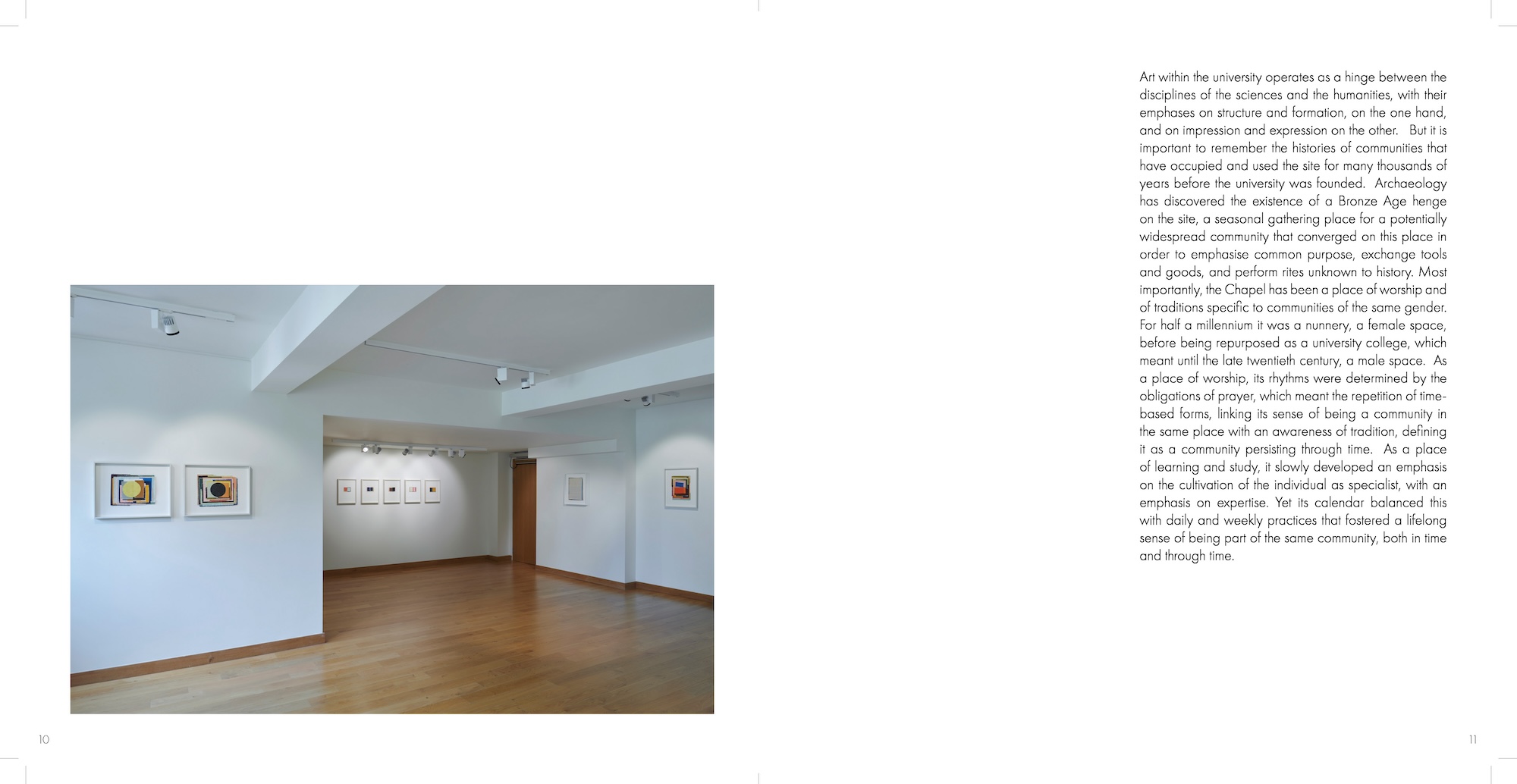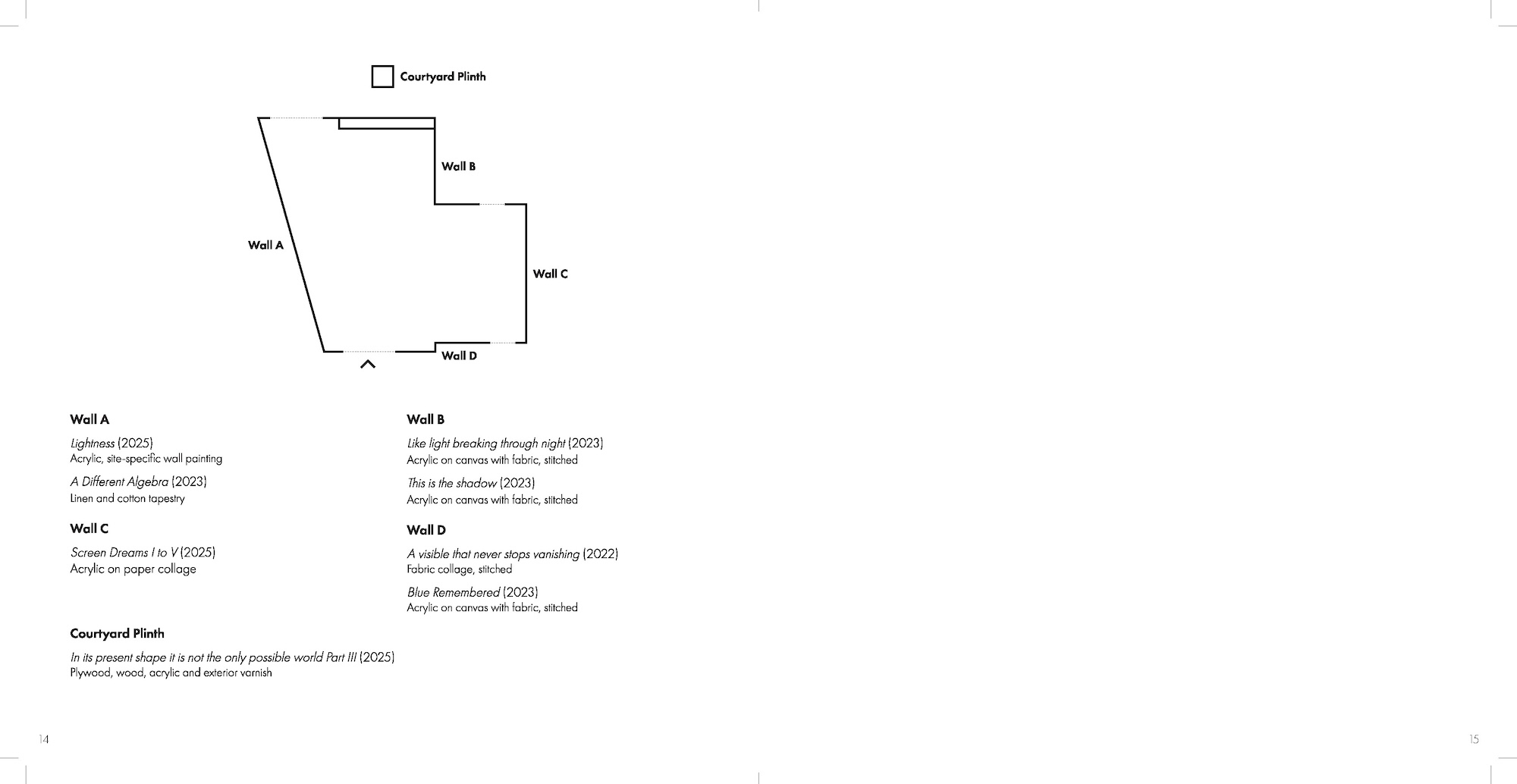Lightness, West Court Gallery, Jesus College Cambridge. 22 May - 26 October 2025.
The Echoic Art of Fiona Curran
‘Sculpture is a part of the space around it.’ This dictum by the Polish Constructivist sculptor Katarzyna Kobro might have been coined with the work of Fiona Curran in mind. Her works in this exhibition that include wall works that resemble books, books that resemble sculptures, and sculptures whose polychrome components recall constructivist paintings, are all in dialogue with the eccentric geometry of the Jesus College exhibition room. Despite being trapped, technically speaking, by the two dimensions of height and breadth, her on-site wallpaintings are comprised of geometrical colour blocks that give the impression of drifting, gliding and hovering in experimental relationship to one another. Frames and parts of frames do not surround and delimit the work but float off into its interior and become part of its exploration of depth.
Curran has noted and adapted to the specific opportunities of the space she has been given to operate in, which calls to mind an opened book or a door left ajar. Whether it sits on, or rather hovers over, a plinth, or slides about within a frame, a work by Fiona Curran is likely to echo the form and meaning of the codex (literally, the trunk of a tree, but conventionally, an unbound manuscript). The codex is traditionally associated with the codification of laws. Curran’s work relates to the traditions of artistic form and genre by unbinding, shuffling and reordering its relations. Within the Exhibition Room of Jesus College, the shifting and loosening forms of individual works imply the possibility of reordering the relations within individual works and between adjacent exhibits. There is a strong sense that the entire show could be re-composed, not just once but throughout the duration of the hang.
Art within the university operates as a hinge between the disciplines of the sciences and the humanities, with their emphases on structure and formation, on the one hand, and on impression and expression on the other. But it is important to remember the histories of communities that have occupied and used the site for many thousands of years before the university was founded. Archaeology has discovered the existence of a Bronze Age henge on the site, a seasonal gathering place for a potentially widespread community that converged on this place in order to emphasise common purpose, exchange tools and goods, and perform rites unknown to history. Most importantly, the Chapel has been a place of worship and of traditions specific to communities of the same gender. For half a millenium it was a nunnery, a female space, before being repurposed as a university college, which meant until the late twentieth century, a male space. As a place of worship, its rhythms were determined by the obligations of prayer, which meant the repetition of time-based forms, linking its sense of being a community in the same place with an awareness of tradition, defining it as a community persisting through time. As a place of learning and study, it slowly developed an emphasis on the cultivation of the individual as specialist, with an emphasis on expertise. Yet its calendar balanced this with daily and weekly practices that fostered a lifelong sense of being part of the same community, both in time and through time.
Fiona Curran’s intervention in this palimpsest of forms and practices has involved the experimental development of palimpsestic artworks, with their geometries echoing one another, while also capturing stages of development from one set of relations to another. We seem to be keeping company with a process that has involved a constant unsettling and resettling of relations and trajectories, both in our occupation and use of the space where this exhibition is taking place, and in our engagement with Curran’s practice, with its formal subtleties and decisive selection of core elements. At first glance, Curran’s work seems dedicated to pure abstraction, but its formal relations, that seem to reflect a ceaseless uncoupling and reordering of elements, time and again offer a precise reflection of the customs, practices and innovations that have defined the history of the location. There is popularly supposed to be a time and a place for everything. Curran’s subtly responsive practice as an artist is focused on the art of fashioning a very precisely calibrated call and response to the time and place of its showing. As such, this is a signature event in the history of art at Jesus.
Rod Mengham
Exhibition Pamphlet (slideshow)








